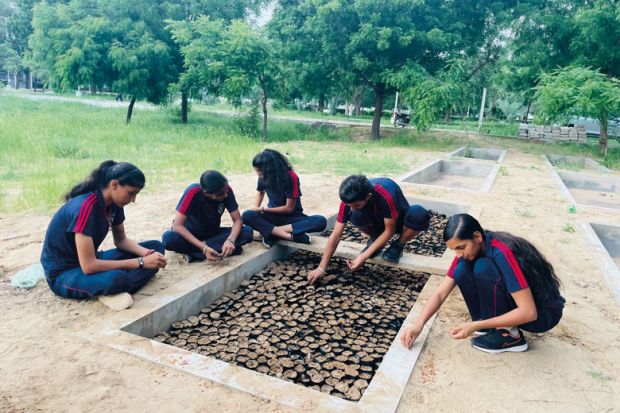Browse the full Impact Rankings 2023 results. To participate in next year’s Impact Rankings, email us
In 2021, after wide consultation, the University of Oxford published its sustainability strategy. The top line was ambitious twin targets of “Net zero carbon and biodiversity net gain by 2035”.
To achieve the latter, we began a partnership between researchers at Oxford and the United Nations Environment Programme Youth and Education division in Nairobi, to try to form a “Race to Net Zero” style movement, but for the higher education sector’s biodiversity impact. We have now built a network of people from more than 500 institutions interested in working together as part of this initiative.
Higher education has a large biodiversity footprint; from the food eaten on campuses, to the land and buildings, to the paper and lab equipment. To start addressing the University of Oxford’s biodiversity footprint, we commissioned a detailed study to provide a baseline. The study used purchasing data, such as laptops bought, flights taken, food consumed. It then converted that into environmental impacts, including those from air, water and land use. Finally, this was converted into a biodiversity measure, which reflects the impact on species and ecosystems. We found that, like with Scope 3 carbon emissions, or the emissions indirectly generated by an organisation, the majority of our impacts on ecosystems are indirect, hidden in our supply chains. At Oxford, we found that our laboratories in particular have a huge impact on nature.
We have defined Nature Positive for universities as “restoring the species and ecosystems that have been harmed by the impacts of the university and its activities and enhancing the university’s positive impacts on nature”.
The aim is to bend the curve on biodiversity loss by 2030 and get ecosystems on track for recovery by 2050. We use a framework called “Four steps for the Earth”, or the Conservation Hierarchy, which is about prioritising a hierarchy of actions to tackle our biodiversity footprint – these are refrain, reduce, restore, renew (4Rs). Importantly starting with avoiding and reducing the most harmful actions wherever possible, and finally restoring and overcompensating for the residual impacts, in order to ultimately have a net positive impact.
The alliance was launched at Kunming-Montreal COP15 with more than 100 founding universities from nearly 50 countries. They have all committed to undertaking their own nature positive journey, by making a pledge including a baseline, targets and actions, as guided by the four Rs, until they can account for and mitigate all their impact at some point in the future.
By doing this transparently, universities can also help to guide their wider communities and partners on a similar journey and inspire their students of all disciplines to be proud of their universities in taking these bold steps. Increasingly, businesses will be forced to disclose their impacts on nature, and universities can lead the way as pioneers that are choosing to do this publicly and giving their students the green skills to take this approach in their future jobs.
We now have a community of more than 100 institutions ready to get to work, and 400 more hopefully soon to follow in their footsteps. One of the first steps will be sharing guidance and case studies from the extended Nature Positive Universities network, with examples of the baseline studies undertaken, targets set and examples of best practice. We want our campuses to be shining examples of urban green spaces and green infrastructure, and renewed spaces for nature and people thriving together.
We have also established a Student Ambassadors programme comprising about 200 students on campuses across the world, to encourage students to get involved in nature restoration and support their universities to start nature positive journeys. Students help us seize the urgency and push their institutions to be more ambitious. Increasingly, students are demanding green jobs and skills and need their university experience to equip them for the climate and ecological challenges ahead. Students can get involved practically with campus wildlife surveys and citizen science, taking action to clean up degraded areas and tackle plastics, and sharing their experiences with a global network of students on campuses across the world, through monthly meetings and online collaboration.
The network is also meant to be a collaboration between universities from different parts of the world, so that we can create new research partnerships that protect and restore biodiversity where it is most vulnerable. We would like to create equitable partnerships between universities with a large biodiversity footprint, and those on the front lines, feeling the effects of climate change and nature degradation, who have the local knowledge to inform the best restoration efforts. We are also establishing regional hubs so that neighbouring universities can support each other in these efforts.
We are excited by the possibilities of universities as beacons for action on nature, involving every part of the university ecosystem, from university management and administration to researchers and students, gardeners and chefs. We welcome you to join us, and a growing community of institutions, leading others on a global nature positive journey.
Emily Stott works in the department of zoology at the University of Oxford and coordinates the Nature Positive Universities initiative. Find out more at www.naturepositiveuniversities.net.
Register to continue
Why register?
- Registration is free and only takes a moment
- Once registered, you can read 3 articles a month
- Sign up for our newsletter
Subscribe
Or subscribe for unlimited access to:
- Unlimited access to news, views, insights & reviews
- Digital editions
- Digital access to THE’s university and college rankings analysis
Already registered or a current subscriber? Login








